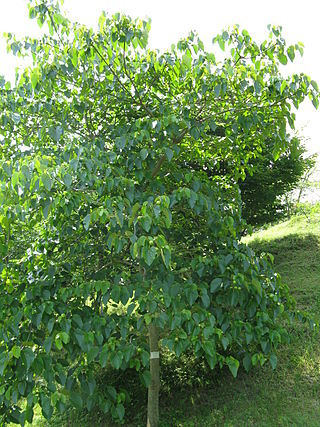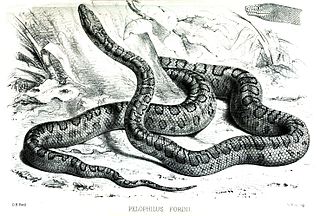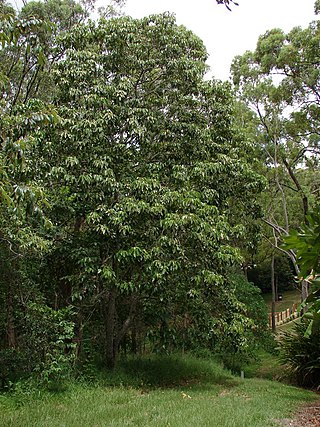
Vernicia fordii is a species of flowering plant in the spurge family native to southern China, Myanmar, and northern Vietnam. It is a small to medium-sized deciduous tree growing to 20 m tall, with a spreading crown. The bark is smooth and thin, and bleeds latex if cut. The leaves are alternate, simple, 4.5–25 cm long and 3.5–22 cm broad, heart-shaped or with three shallow, maple-like lobes, green above and below, red conspicuous glands at the base of the leaf, and with a 5.5–26 cm long petiole. The flowers are 2.5–3.5 cm diameter, with five pale pink to purple petals with streaks of darker red or purple in the throat; it is monoecious with individual flowers either male or female, but produced together in the inflorescences. The flowers appear before or with the leaves in loose, terminal clusters. The fruit is a hard, woody pear-shaped berry 4–6 cm long and 3–5 cm diameter, containing four or five large, oily seeds; it is green initially, becoming dull brown when ripe in autumn.
Aleurite is an unconsolidated sediment with a texture intermediately between sand and clay, similar to silt, with particle sizes ranging from 0.01 to 0.1 millimetres.

Aleurites moluccanus, the candlenut, is a flowering tree in the spurge family, Euphorbiaceae, also known as candleberry, Indian walnut, kemiri, varnish tree, nuez de la India, buah keras, godou, kukui nut tree, and rata kekuna.

Aleurites is a small genus of arborescent flowering plants in the Euphorbiaceae, first described as a genus in 1776. It is native to China, the Indian Subcontinent, Southeast Asia, Papuasia, and Queensland. It is also reportedly naturalized on various islands as well as scattered locations in Africa, South America, and Florida.

The Azeemi Sufi Order, known in Urdu as Silsila Azeemiyya , known in Arabic as Al-Ṭarīqah al-Aẓeemiyyah
Candlenut oil or kukui nut oil is extracted from the nut of Aleurites moluccanus, the candlenut or kuku'i.
Shams al-Din is an Arabic personal name or title.
Abdul Aziz bin Shamsuddin was a Malaysian politician who served as Minister of Rural and Regional Development from 2004 to 2008.

Erythrophleum fordii is a species of plant in the family Fabaceae. It is a tree about 10 metres (33 ft) tall, occasionally reaching 30 metres. It is found in southeastern China, Taiwan, and Vietnam. It is a valuable timber tree threatened by overexploitation. It is under second-class national protection in China.
The molecular formula C21H20O9 (molar mass: 416.38 g/mol, exact mass: 416.1107 u) may refer to:

Chilabothrus fordii, also known commonly as Ford's boa and the Haitian ground boa, is a species of snake in the family Boidae. There are three recognized subspecies.

Aleurites rockinghamensis, the candlenut, is a flowering tree in the spurge family, Euphorbiaceae found in northeastern Australia. It was first formally described and named by French botanist Henri Ernest Baillon as a variety of Aleurites moluccanus, as Aleurites moluccanus var. rockinghamensis in 1866. The Australian botanist Paul Irwin Forster promoted it to distinct species status in 1996. The type specimen was collected in Rockingham Bay, Queensland. It occurs in Australia and Papua New Guinea.

Coumarinolignoids are a class of phenolic compounds. They are a subset of lignans in which one of the two phenylpropanoids is found in the form of a coumarin.

Durantin A is a bio-active coumarinolignoid isolated from the flowering plant Duranta repens.
Berberis fordii is a species of shrub in the Berberidaceae described as a species in 1913. It is endemic to China, found in Chongqing and Guangdong Provinces.
LaDema Mary Langdon was an American botanist known for her work on floral anatomy, taxonomy, embryology, and morphology of Juglandaceae, Fagaceae,Cycas, and Dioon spinulosum. She was a member of the American Association for the Advancement of Science and was a professor at Baltimore Junior College and Goucher College. She earned her bachelor's degree from Oberlin College and her graduate degrees from the University of Chicago.

Khawaja Shamsuddin Azeemi is a Pakistani scholar in the field of spiritualism and a Sufi master. He is the current head of the Azeemia Sufi order. He has written books on the subject of spirituality or Muraqaba and is the chief editor of the monthly Roohani Digest and Qalander Shaoor in Karachi, Pakistan. He has established a chain of fifty-three meditation centers worldwide.
Euproctis fraterna is a moth of the family Erebidae first described by Frederic Moore in 1883. It is found in the Maldives, India, Sri Lanka and the Seychelles.

Cheromettia apicata is a moth of the family Limacodidae first described by Frederic Moore in 1879. It is found in Oriental tropics such as Sri Lanka and India.











